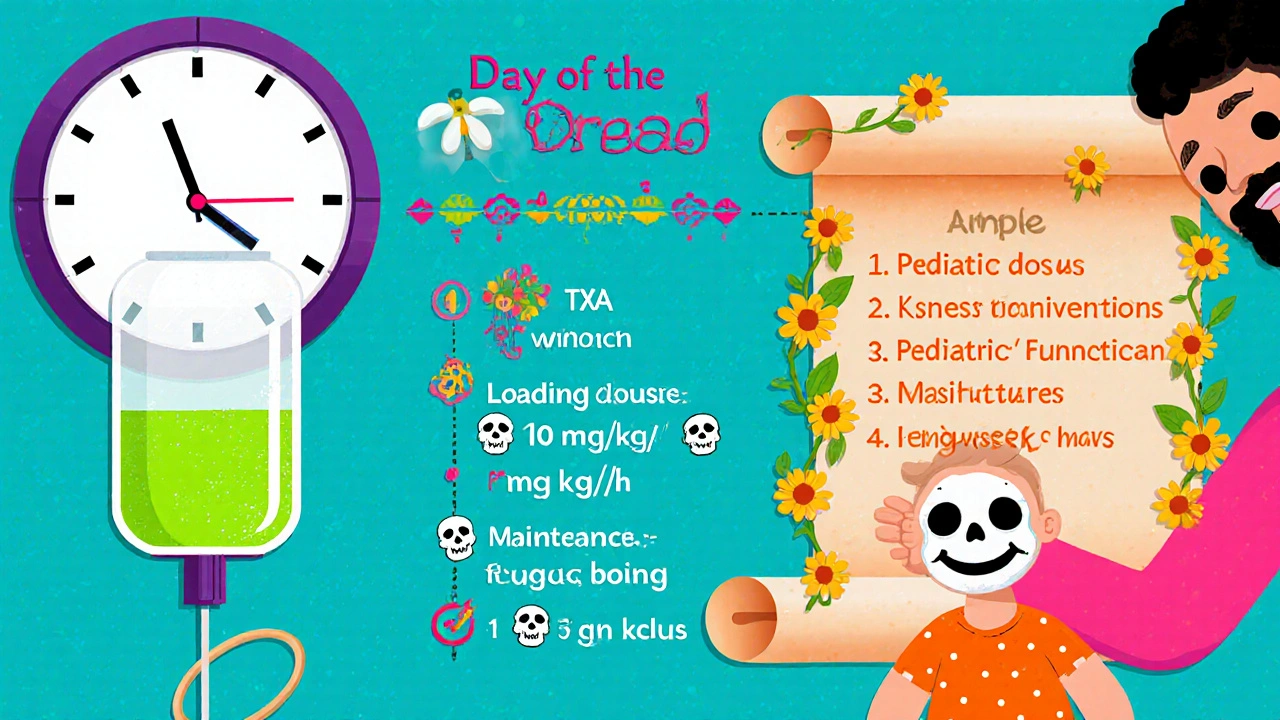Tranexamic Acid Dosing Calculator
Dosing Calculator
Calculate appropriate tranexamic acid doses for surgical patients based on weight and procedure type
Enter patient weight to see calculated doses
Safety Considerations
Do not administer if patient has active thrombo-embolism or severe renal impairment (eGFR < 30 mL/min)
Administer within 10-15 minutes of incision for optimal effect
Quick Takeaways
- Tranexamic acid cuts surgical blood loss by 20‑30% on average.
- Give the drug within 10‑15 minutes before the incision for best effect.
- Typical IV dose: 10mg/kg loading, then 1mg/kg/h infusion.
- Contraindications include active thrombo‑embolism and severe renal impairment.
- TXA is cheaper and easier to use than most alternatives such as epsilon‑aminocaproic acid.
Post‑operative bleeding can turn a routine operation into a life‑threatening emergency. Surgeons and anesthesiologists keep a close eye on blood loss, but the real game‑changer is the drug that stops the bleeding before it starts. That drug is tranexamic acid, a synthetic antifibrinolytic that blocks the breakdown of clots. In the next sections we’ll break down how it works, when to use it, and what the latest studies say about safety.
What is Tranexamic Acid?
Tranexamic Acid is a lysine‑derived molecule approved in the 1960s for controlling heavy menstrual bleeding. Its chemical name is 4‑(amino‑methyl)cyclohexanecarboxylic acid, and it belongs to the class of antifibrinolytics. By binding to plasminogen, it prevents the conversion of plasminogen to plasmin, the enzyme responsible for dissolving fibrin clots.
How It Stops Post‑operative Bleeding
The body’s clotting system creates a fibrin mesh that seals blood vessels. At the same time, a parallel system called fibrinolysis (see Fibrinolysis) constantly trims excess clot. During major surgery, the balance tips toward too much fibrinolysis, which leads to oozing from the wound. Tranexamic acid plugs that leak by blocking the lysine binding sites on plasminogen, effectively “locking” the fibrin mesh in place.
Because it works upstream of the clot‑dissolving cascade, TXA does not interfere with the initial formation of clots (the Coagulation cascade) - it simply preserves what the body has already built.

Clinical Evidence: Numbers You Can Trust
Multiple randomized trials have quantified the benefit. A 2022 meta‑analysis of 45 surgical specialties reported an average reduction of 300mL in intra‑operative blood loss and a 30% drop in transfusion rates when TXA was used. In orthopedic procedures like total knee replacement, the average hemoglobin drop fell from 3.2g/dL to 2.1g/dL, shaving off about 1unit of packed red blood cells per patient.
Cardiac surgery data are equally compelling. The 2023 ATACAS trial, involving 4,600 patients undergoing coronary artery bypass grafting, showed a 2.9% absolute reduction in major bleeding events without a rise in thrombotic complications.
Safety signals are reassuring. The same meta‑analysis found no statistically significant increase in deep‑vein thrombosis, pulmonary embolism, or stroke when TXA was dosed according to guidelines.
Practical Guide: Dosing, Routes, and Timing
Getting the timing right matters as much as the dose. The ideal window is the first 15minutes of skin incision; after that, the clot‑preserving effect wanes.
- IV loading dose: 10mg/kg over 10minutes.
- Maintenance infusion: 1mg/kg/h until wound closure.
- Oral alternative: 20mg/kg given 1hour before surgery (useful for spine and orthopedic procedures).
For patients with renal insufficiency (eGFR<30mL/min), reduce the loading dose to 5mg/kg and avoid prolonged infusion. In children, pediatric dosing follows 15mg/kg IV bolus, then 5mg/kg/h infusion.
Monitor for signs of thrombosis, especially in patients with a history of deep‑vein thrombosis, atrial fibrillation, or recent myocardial infarction. Routine labs include hemoglobin, platelet count, and serum creatinine at baseline and 24hours post‑operatively.

Alternatives and How They Stack Up
If TXA isn’t available, surgeons sometimes turn to other antifibrinolytics such as Epsilon‑aminocaproic acid (EACA) or the vasopressin analog Desmopressin. The table below compares the three on key parameters.
| Drug | Typical Dose | Cost (US$ per 100mg) | Onset | Key Contra‑indication |
|---|---|---|---|---|
| Tranexamic Acid | 10mg/kg IV load | 0.15 | 5‑10min | Active thrombo‑embolism |
| Epsilon‑aminocaproic Acid | 100mg/kg IV | 0.20 | 15‑20min | Severe renal failure |
| Desmopressin | 0.3µg/kg IV | 0.35 | 30‑45min | Hyponatremia risk |
TXA wins on speed of onset, cost, and breadth of evidence. EACA is useful when high-dose TXA is contraindicated, but it requires larger volumes. Desmopressin is a good choice in patients with platelet dysfunction rather than fibrinolysis.
Common Pitfalls and Pro Tips
- Pitfall: Giving TXA after massive bleeding has already started. Tip: Load before incision, even for short procedures.
- Pitfall: Ignoring renal function. Tip: Adjust dose for eGFR<30mL/min and consider oral route for mild impairment.
- Pitfall: Over‑relying on TXA to replace good surgical technique. Tip: Combine TXA with meticulous hemostasis and temperature management.
- Pitfall: Forgetting to document the dose. Tip: Use the peri‑operative checklist to record loading and maintenance amounts.
Frequently Asked Questions
Can I give tranexamic acid to patients on anticoagulants?
Yes, but use caution. If the patient is on a reversible anticoagulant (e.g., warfarin with a normal INR), TXA can safely reduce bleeding. For direct oral anticoagulants, pause the medication as per protocol before surgery.
Is there a maximum lifetime dose for TXA?
No cumulative lifetime limit has been established. The limiting factor is the acute dose per surgery and the patient’s renal clearance.
What’s the difference between IV and oral TXA?
IV delivery reaches peak plasma levels within minutes, ideal for high‑risk bleeding. Oral dosing peaks in 1‑2hours and is useful for procedures where a slower onset is acceptable.
Does TXA increase the risk of seizures?
High doses (>100mg/kg) used in cardiac surgery have been linked to seizures in a small subset of patients. Keep to recommended dosing and monitor neurologic status.
Can tranexamic acid be used in pediatric surgery?
Yes. Doses of 15mg/kg IV bolus followed by 5mg/kg/h infusion are standard for children undergoing spinal or craniofacial operations.
When used correctly, tranexamic acid turns a bleeding‑prone operation into a safer, cleaner case. By understanding the mechanism, dosing nuances, and safety profile, clinicians can cut down on transfusions, shorten hospital stays, and keep patients out of the ICU.


Grace Hada
October 17, 2025 AT 21:10Tranexamic acid is a slick money‑maker for pharma, and we’re supposed to swallow the hype without a second thought.
nitish sharma
October 18, 2025 AT 19:23While I appreciate your candor regarding the commercial aspects, it is imperative to recognize that the pharmacodynamic profile of tranexamic acid has been rigorously evaluated in peer‑reviewed literature. The drug’s mechanism, which involves competitive inhibition of plasminogen activation, provides a predictable reduction in fibrinolysis when administered within the recommended peri‑operative window.
Rohit Sridhar
October 19, 2025 AT 17:37Honestly, the numbers are hard to ignore – a 20‑30% drop in blood loss translates to fewer transfusions and quicker recoveries. Surgeons love it because it buys them time in the OR, and patients love it because it cuts postoperative anemia. The dosing schedule is straightforward, so it fits nicely into most ERAS protocols. In my experience, the safety profile holds up across orthopaedic and cardiac cases. Just remember to adjust for renal function.
Sarah Hanson
October 20, 2025 AT 15:50The loading dose of 10 mg/kg over ten minutes followed by a 1 mg/kg/h infusion is the sweet spot for most procedures. Timing is key – get it on board before the incision and you’ll see the benefit. For patients with eGFR <30 mL/min, halve the dose to stay safe. It’s a simple protocol that many centres have adopted as standard.
Nhasala Joshi
October 21, 2025 AT 14:03🚨👁️🗨️ Ever wonder why the “official” guidelines barely mention the shadowy side‑effects? Some say the data is cherry‑picked, others whisper about a secret consortium pushing TX A to boost hospital revenues. Don’t forget, excessive inhibition of fibrinolysis could, in theory, tip the scales toward dangerous micro‑thrombi – especially in high‑risk cardiac patients. Stay woke, folks! 🧠💊
kendra mukhia
October 22, 2025 AT 12:17Look, if you think TXA is a miracle drug, you’re missing the nuance. Sure, it slashes blood loss, but you can’t ignore the fact that many junior surgeons rely on it as a crutch instead of mastering meticulous hemostasis. The “one‑size‑fits‑all” dosing is a myth; patient‑specific factors matter. Don’t let marketing hype blind you.
Bethany Torkelson
October 23, 2025 AT 10:30This drug is practically a superhero in the OR, yet some people act like it’s a witch’s potion. The evidence is solid, but the drama surrounding its use is overblown. Let’s keep the conversation grounded in data, not hysteria.
alex montana
October 24, 2025 AT 08:43TXA works…? actually it works great,, yet some docs forget… the timing!! administer before incision… and you’re golden… otherwise… you might as well be… drinking water???
Wyatt Schwindt
October 25, 2025 AT 06:57Good point on renal dosing; adjusting the infusion can prevent accumulation.
Lyle Mills
October 26, 2025 AT 04:10The antifibrinolytic action of tranexamic acid, via lysine‑binding site blockade on plasminogen, is a classic example of targeted pharmacology reducing peri‑operative hemorrhage without compromising primary clot formation.
Barbara Grzegorzewska
October 27, 2025 AT 02:23When one surveys the landscape of peri‑operative hemostasis, tranexamic acid emerges not merely as a pharmaceutical adjunct but as a paradigm shift that challenges entrenched notions of inevitable surgical blood loss.
Its molecular choreography-binding to the kringle domains of plasminogen and thereby thwarting its conversion to plasmin-represents a masterstroke of biochemical ingenuity.
The empirical evidence, amassed across orthopedic, cardiac, and obstetric domains, consistently demonstrates a reduction in transfusion requirements that hovers between twenty and thirty percent.
Such a decrement translates into tangible cost savings for health systems already strained by the soaring expense of blood products.
Moreover, the attenuation of postoperative anemia curtails the length of hospital stays, fostering a more rapid return to functional independence for patients.
Nonetheless, one must not be lulled into complacency, for the pharmacokinetic profile of TXA necessitates vigilant renal dosing adjustments lest accumulation precipitate an iatrogenic pro‑thrombotic milieu.
In patients with an eGFR below thirty millilitres per minute, a halved regimen or an outright oral alternative may preserve efficacy while safeguarding against adverse events.
Critics occasionally brand the drug as a ‘blood‑thinner’ masquerading as a hemostatic agent, but such caricatures betray a superficial grasp of its mechanistic underpinnings.
The meta‑analysis of forty‑five surgical specialties, published in 2022, underscores not only statistical significance but also clinical relevance-a nuance often lost in headline‑driven summaries.
Equally compelling is the ATACAS trial, whose robust sample size of four thousand six hundred patients provides a bulwark against accusations of methodological fragility.
Even within that trial, the incidence of deep‑vein thrombosis and pulmonary embolism did not ascend, refuting the oft‑cited specter of hypercoagulability.
It is, however, incumbent upon the surgical team to integrate TXA into an evidence‑based protocol rather than employing it as a reflexive panacea.
Such protocols should delineate precise timing-ideally within fifteen minutes of incision-and articulate clear parameters for cessation upon wound closure.
When institutional pathways adhere to these standards, the synergy between pharmacologic and surgical hemostasis becomes palpable, elevating patient outcomes across the board.
In sum, tranexamic acid stands as a testament to how a modest molecular tweak can reverberate through the entire peri‑operative continuum, delivering benefits that are both economical and clinically profound.
Nis Hansen
October 28, 2025 AT 00:37Consider the broader ethical canvas: deploying a drug that can spare a unit of blood per patient is not merely a clinical decision but a stewardship of a scarce resource. By integrating tranexamic acid into standardized pathways, we honor both patient safety and societal responsibility.
Fabian Märkl
October 28, 2025 AT 22:50Really love how TXA streamlines surgeries 🚀-less blood loss, smoother recoveries, and it’s cost‑effective! 👍 Keep the data flowing, and let’s keep improving protocols together.
Avril Harrison
October 29, 2025 AT 21:03Interesting read – never realised just how much timing mattered for TXA. Guess I’ll bring it up at the next journal club.
Natala Storczyk
October 30, 2025 AT 19:17THIS IS WHY AMERICAN SURGERIES ARE LEADING THE WORLD-WE EMBRACE TXA AND CUT BLOOD LOSS LIKE NO ONE ELSE!!! OUR PATIENTS DESERVE THE BEST, AND WE DELIVER IT WITH UNWAVERING CONFIDENCE!!!!